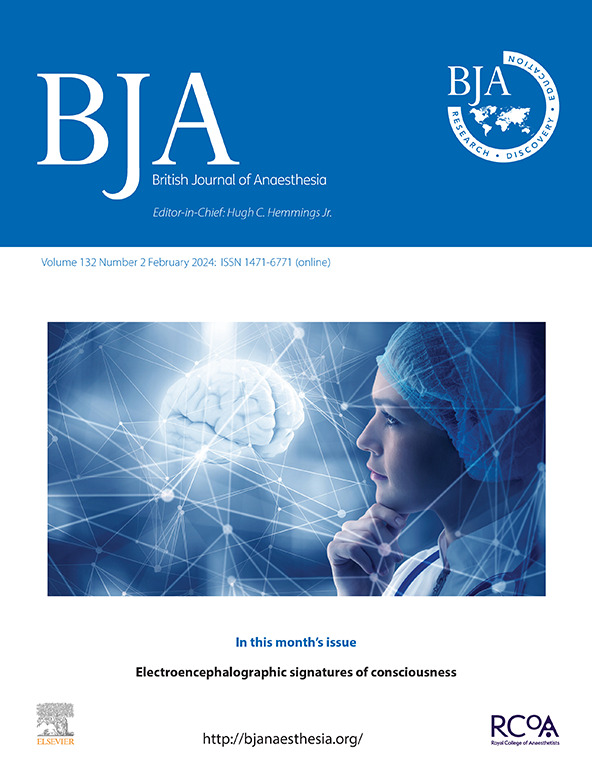Bone cement implantation syndrome: a scoping review.
IF 9.1
1区 医学
Q1 ANESTHESIOLOGY
引用次数: 0
Abstract
BACKGROUND Bone cement implantation syndrome comprises the occurrence of hypoxaemia, hypotension, unexpected loss of consciousness, or cardiac arrest occurring around the time of cementation, prosthesis insertion, or reduction of the joint in arthroplasty. As the yearly number of arthroplasties will increase, the number of complications including bone cement implantation syndrome is also expected to increase. Therefore, a good understanding of this syndrome is important. This scoping review aims to provide a comprehensive overview of the current knowledge of bone cement implantation syndrome. METHODS This scoping review was conducted based on the PRISMA-ScR Checklist. A literature search was done in PubMed, Cochrane, and Embase. A total of 85 studies were included in the study. RESULTS The incidence of bone cement implantation syndrome during cemented hip or knee arthroplasty varied from 15.4% to 46.7% and 27.5% to 70.7%, respectively. The incidence in shoulder arthroplasty was 16.2%. In uncemented hip arthroplasty, the incidence ranged from 0.0% to 21.8%. Risk factors identified for bone cement implantation syndrome included advanced age, ASA physical status 3 or 4, and primary lung cancer or lung metastasis. CONCLUSIONS Bone cement implantation syndrome is a potentially severe complication that can occur during both cemented and uncemented arthroplasty. Moreover, the occurrence of bone cement implantation syndrome is not dependent on the use of cement. However, the severity does seem to have an association with the fixation method.骨水泥植入综合征:范围综述。
骨水泥植入综合征包括在骨水泥植入、假体植入或关节置换术中复位期间发生的低氧血症、低血压、意外意识丧失或心脏骤停。随着每年关节置换术数量的增加,包括骨水泥植入综合征在内的并发症数量预计也会增加。因此,很好地理解这种综合征是很重要的。这篇综述的目的是对骨水泥植入综合征目前的知识提供一个全面的概述。方法根据PRISMA-ScR检查表进行范围审查。在PubMed、Cochrane和Embase中进行了文献检索。该研究共纳入了85项研究。结果骨水泥置换术中骨水泥植入综合征的发生率分别为15.4% ~ 46.7%和27.5% ~ 70.7%。肩关节置换术的发生率为16.2%。在非骨水泥髋关节置换术中,发生率从0.0%到21.8%不等。骨水泥植入综合征的危险因素包括高龄、ASA身体状态3或4、原发性肺癌或肺转移。结论骨水泥植入综合征是骨水泥置换术和非骨水泥置换术中潜在的严重并发症。此外,骨水泥植入综合征的发生并不依赖于骨水泥的使用。然而,其严重程度似乎与固定方法有关。
本文章由计算机程序翻译,如有差异,请以英文原文为准。
求助全文
约1分钟内获得全文
求助全文
来源期刊
CiteScore
13.50
自引率
7.10%
发文量
488
审稿时长
27 days
期刊介绍:
The British Journal of Anaesthesia (BJA) is a prestigious publication that covers a wide range of topics in anaesthesia, critical care medicine, pain medicine, and perioperative medicine. It aims to disseminate high-impact original research, spanning fundamental, translational, and clinical sciences, as well as clinical practice, technology, education, and training. Additionally, the journal features review articles, notable case reports, correspondence, and special articles that appeal to a broader audience.
The BJA is proudly associated with The Royal College of Anaesthetists, The College of Anaesthesiologists of Ireland, and The Hong Kong College of Anaesthesiologists. This partnership provides members of these esteemed institutions with access to not only the BJA but also its sister publication, BJA Education. It is essential to note that both journals maintain their editorial independence.
Overall, the BJA offers a diverse and comprehensive platform for anaesthetists, critical care physicians, pain specialists, and perioperative medicine practitioners to contribute and stay updated with the latest advancements in their respective fields.

 求助内容:
求助内容: 应助结果提醒方式:
应助结果提醒方式:


